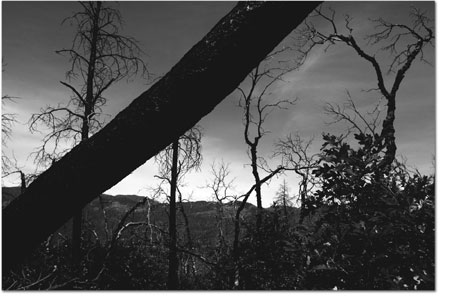|
| ||||
| After the fires SideStory: Remembering, learning, preparing: A look at ‘Missionary Ridge, Five Years After the Fire’
by Will Sands Five years ago, on June 9, a cigarette butt or a spark flew from a vehicle on the edge of Missionary Ridge Road. What started as a small fire just northwest of Durango rapidly grew into a massive, out-of-control blaze. Over the next 37 days, the Missionary Ridge Fire swept through more than 73,000 acres, destroyed 46 homes and forced thousands of evacuations. On June 25, 2002, an electrical fence designed to burn weeds sparked another wildfire on the opposite side of the Animas Valley. Ten homes and 439 acres burned before the fire was contained the next morning. All told, the two wildfires cost nearly $40 million to fight and represented an unprecedented disaster for La Plata County. Five years later, a diverse group of community members are unveiling an ambitious event to commemorate and raise awareness about the milestone in the community’s history. The June 8-10 happening has been tagged, “Missionary Ridge Five Years After the Fire: Remember, Learn, Prepare.” Tim Walsworth, president of the United Way and a member of the event’s steering committee, commented that the five-year anniversary is a ripe moment to revisit the wildfires of 2002. “Tons of new people have come into our community since 2002,” he said. “Complacency has also set in over time for people who were here during the fires. We feel that the time is right to remember what happened, honor the sacrifices and to learn and get people to prepare for the future.” This weekend’s happenings represent much more than a celebration, according to Allison Pease, executive director of Durango Nature Studies and a steering committee member. “What we didn’t want to do was make this any kind of celebration or fund-raiser,” she said. “More than anything we wanted to make this an awareness-raiser.” Walsworth added, “This was a bad time in our community’s history. You don’t celebrate those kinds of things. We’re honoring and remembering. Then hopefully we’ll be learning and preparing.” As with the fires themselves, diverse groups have coalesced around the awareness-raiser. The United Way and Durango Nature Studies have been joined by the Southwest Medical Reserve Corps and the La Plata County Office of Emergency Management in staging the event. “The community collaborated like never before when the fires actually happened,” Walsworth said. “Now as we’re honoring that, we’ve got a strong collaboration five years later. We have an environmental bent, a human services angle and a disaster-response approach. At the end of the day, our event will be better because of it.” For Walsworth, reflecting on the Missionary Ridge Fire conjures up memories of transitions. He was living in Colorado Springs at the time of the blazes, but relocated to Durango shortly thereafter. As president of the United Way, he was actively involved with a joint public/private effort known as the Disaster Recovery Coalition and helping people rebuild from the ashes.
“The fires themselves were over when I arrived, but the damage had been done and the community was still responding,” Walsworth recalled. “During that time, I learned that when we’re in trouble, we really help our own in Durango. It truly is neighbors helping neighbors.” From a naturalist’s perspective, the five-year anniversary of the fire is significant for a different reason. “From a nature point of view, the point between five and seven years after is when the dead trees start falling down,” Pease said. “For me, that’s a moment of reflection. Once again the forest is in a dynamic state.” Fire is not considered disastrous from an ecological perspective, Pease added. Regular wildfire is crucial to forest health and ensuring that biodiversity is not replaced by monoculture. “Going into a forest after a fire, there appears to be so much devastation, but there’s also a deeper picture, and fire is a vital part of the ecosystem,” Pease said. For Pease, the “learn” portion of the Missionary Ridge event centers largely around the danger of fire suppression. According to the laws of nature, ponderosa forests should burn every two to 12 years, she said. Suppression, on the other hand, may protect homes and cities in the short run, but it also creates conditions that could lead to catastrophic events like the Missionary Ridge and Valley fires. “Fire has been a natural part of the West’s ecosystem for tens of thousands of years,” she said. “It’s only since fire suppression was put into place 100 years ago that we’ve had a problem that’s essentially manmade.” The human element is what made the Missionary Ridge and Valley fires different and what makes this weekend’s event essential for the future. “Unfortunately, the fires affected people, homes and watersheds,” Pease said. “There was a major community impact.” For Walsworth, the human element is also at the top of his list. “My angle is future preparedness as well as honoring the way the community came together in the wake of the fire,” he said. That aftermath made spearheading “Missionary Ridge Five Years After the Fire” a no-brainer for Walsworth. “The community spirit continued long were put out,” he concluded. “That spirit is still continuing. That impressed me and makes me want to continue to be involved.” •
|



